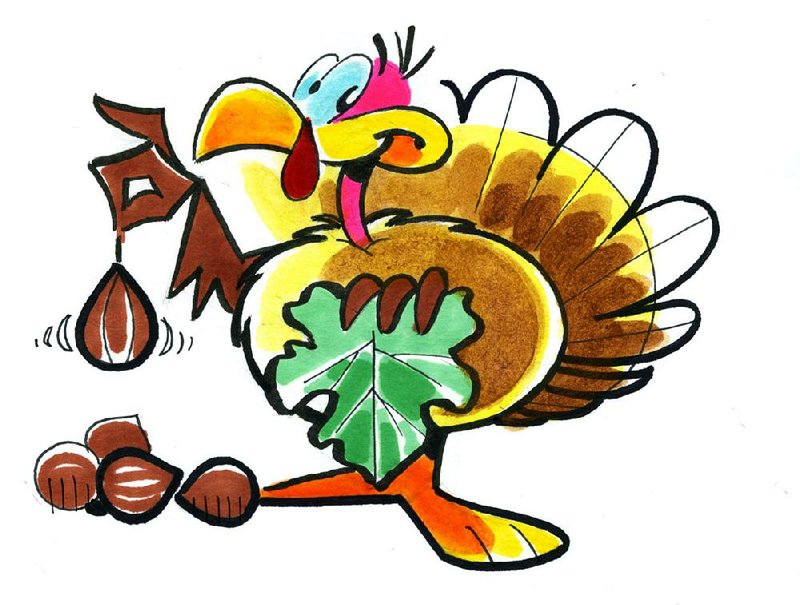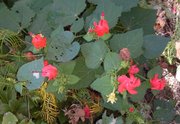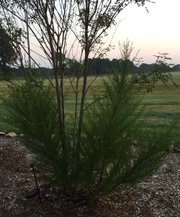Q I have a 12-year-old Turkish brown fig tree that is about 8 feet tall. Last winter it froze to the ground. I wanted to get rid of it, but my wife asked me to give it a chance to survive. It did and now has a lot of figs on it. Because they came on so late, I don't think they will have a chance to ripen. I would like to protect this fig bush this fall and winter. Is there a practical way to protect it from freezing? It is in the middle of my backyard.
A I believe you have a Brown Turkey fig -- the most common fig grown in Arkansas. When I started work back in 1980, we used to call them fig bushes, because they were frozen to the ground so frequently. Then our winters became milder, and we started getting large fig trees. The past two winters were reminiscent of the '80s and many trees took a hit with the colder than normal winter. The beauty of Brown Turkey is that it can bear fruit on its new growth as well as the old. These trees have the potential to carry two crops per year. Your late-season crop (in a milder growing location) could overwinter and be harvested very early in the spring, and then another crop would be produced that would have larger fruits. To answer your question about protection, the best suggestion would be to build a cage around the tree, as large as you can manage in height and width. Gradually add leaves to the cage. Don't pack the leaves in, just lightly fill. In really cold weather -- in the single digits -- you could add an extra layer of protection by wrapping the cage with a sheet or even plastic. When we are frost-free, release the cage and rake away the leaves.
Q I have a fernlike plant growing wild in my garden. The stalks are rather thick and sturdy, with feathery offshoots. It developed tiny purple flowers that you had to be right up next to the plant to see.
A You have two plants growing together. The wispy plant with ferny leaves is a common weed called dog fennel (Eupatorium capillifolium). It can grow quite tall and has a white flower. It can be aggressive and so is better pulled out and destroyed, even though it does have a nice texture. I think that in your yard, it is growing beside a very leggy chaste tree or vitex. This plant can be grown as a small tree or a large shrub. It has compound leaves and a purple flower spike.
Q I need help in caring for my azaleas. When should I water and feed, and do they need sprays? I have the spring-blooming-only azaleas and Encores. One seems to be dying, and one is looking a little discolored.
A Now is not the time to do anything but water your azaleas when they need water. Spring-blooming azaleas have set their flower buds, and Encores are blooming now. Azaleas don't tolerate drought very well. Getting too dry can cause some discoloration of the leaves. But don't be alarmed if your white or light pink azaleas begin to shed some yellow leaves -- these are old leaves, and they often yellow before falling. Gardenias can do the same thing. Also, darker flowering reds and purples often take on a purplish leaf color for the winter. The leaf sample you sent did not have any disease or insect infestation, so no sprays seem to be needed. I don't recommend preventive sprays on azaleas unless there have been disease problems. Monitor your azaleas next spring and observe how they bloom and begin growth. Fertilize once a year after they finish blooming. Do any needed pruning then as well.
Q Can you please identify this plant for me? I grew it from a seed I harvested outside a building in southern Arkansas three years ago. I mulched it heavily last winter not knowing if it would survive our Northwest Arkansas winter. But it came back and it has grown 2 to 3 feet tall with multiple stems and numerous blossoms. What is it and what is its hardiness level?
A The plant in question is commonly called Turk's cap or Turk's turban. It is Malvaviscus arboreus, a great perennial in most of our state, but it would need a bit of help in the northern tier. It should be hardy to about zero. I think piling an extra layer of mulch over your plants once they go dormant is a great idea to protect it. Save some seeds as added protection. Hummingbirds and butterflies love this late-season bloomer, which is a member of the hibiscus family.
Janet B. Carson is a horticulture specialist for the University of Arkansas Cooperative Extension Service. Write to her at 2301 S. University Ave., Little Rock, Ark. 72204 or email her at
jcarson@arkansasonline.com
HomeStyle on 10/17/2015


